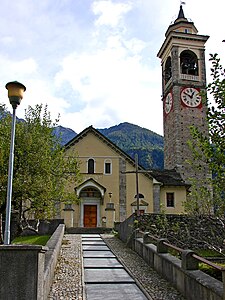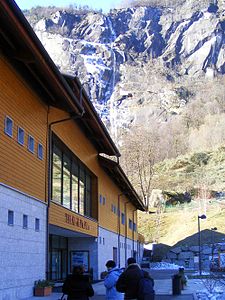Premia (Piedmont)
| Premia | ||
|---|---|---|

|
|
|
| Country | Italy | |
| region | Piedmont | |
| province | Verbano-Cusio-Ossola (VB) | |
| Coordinates | 46 ° 16 ′ N , 8 ° 20 ′ E | |
| height | 800 m slm | |
| surface | 88.90 km² | |
| Residents | 539 (Dec. 31, 2019) | |
| Population density | 6 inhabitants / km² | |
| Post Code | 28866 | |
| prefix | 0324 | |
| ISTAT number | 103056 | |
| Popular name | premiesi | |
| Patron saint | Michael ( September 29 ) | |
| Website | Premia | |
Premia is an Italian commune in the Antigorio Valley in the Verbano-Cusio-Ossola (VB) province in the Piedmont region .
geography
The municipality covers an area of 88.90 km². To Premia include fractions Albogno, Altoggio, Cadarese, Case Cini, Case Francoli, Cagiogno, Chioso, Crego, Cresta, Cristo, Passo, Piazza, Piedilago, Pioda, Rivasco, Rozzaro, Sagiago, Salecchio Inferiore, Salecchio Superiore, San Rocco and Uriezzo. The neighboring municipalities are Baceno , Crodo , Formazza and Montecrestese .
The gorges of Uriezzo are partly in the municipal area .
history
The village name could be derived from the Latin proedium "country estate". According to local tradition, there was a hamlet called Premia between Pioda and Rozzaro in ancient times; graves from the time of Emperor Augustus and a hand mill from pre-Roman times were later found there.
Former Walser settlements
The district of Salecchio ( Saley in German ) , which is located on the mountainside and is no longer inhabited all year round, with the groups of houses Salecchio Inferiore (Untersaley), Salecchio Superiore (Obersaley) and Casa Francoli (Francohüs) is a Walser settlement and was only incorporated into the municipality of Premia in 1929. The most Alemannic dialect spoken here, Saley German as a special dialect of Valais German , has practically died out, but can be found in the language atlas of German-speaking Switzerland , in a publication in the phonogram archive of the University of Zurich and in a dissertation by Gertrud Frei.
Premia now also includes the area of the Walser German community Agaro (German Áger ) (1561 m), which was repealed in 1929 . The main settlement of the same name and the Margone group of houses were flooded in 1938 ( Lago di Agaro ). The hamlet of Ausone (German Opsu, 1463 m) was also abandoned in the 20th century . Like Salecchio, Agaro and Ausone were German-speaking Walser settlements until recently; The dialect was also documented by the Zurich phonogram archive. The population of Agaro spent the winter months in small hamlets on the sunny southern slope above the municipality of Baceno such as Cologno, Costa and Pioda Calva.
population
| Population development | |||||||||||||||
|---|---|---|---|---|---|---|---|---|---|---|---|---|---|---|---|
| year | 1861 | 1881 | 1901 | 1931 | 1951 | 1971 | 1991 | 2001 | 2011 | 2018 | |||||
| Residents | 1403 | 1516 | 1129 | 1289 | 1128 | 867 | 660 | 603 | 577 | 557 | |||||
Attractions
- The three-aisled parish church of San Michele is located in an elevated position above the village and is reached via a wide staircase. It was built in the first half of the 17th century according to the plan of a chapel, which was built in 1250 by Guido II. De Rodis. The main altar is made of carved and gilded wood; valuable frescoes with members of the De Rodis family and the painting Sant'Antonio Abate e Santi Sebastiano e Rocco can be found in the presbytery, both from the 16th century.
- The oratory and the St. Bernard Hospice , of which only remains remain, were founded in the 13th century by Messrs De Rodis. The Oratory San Bernardo (with changes from 1598 and 1700) is located on the old trade route that connected the Ossola Valley with Switzerland via the Gries Pass . At the back of the building are the remains of a 14th century fresco.
- The sanctuary of Don Lorenzo Dresco in the district of Crego was built between 1852 and 1878 by the "stonemason priest" Dresco and contains a peristyle with 48 square columns made of worked stone. The altars are dedicated to the Immaculate Conception , the Mater Dolorosa and Our Lady on Mount Carmel .
- The medieval tower in the Christo district consists of four floors. It served as a signal tower and was - like many other buildings in the area - built on the orders of the Duke of Milan .
- La Ghiacciaia or Nevéra is a cylindrical structure and was used to cool food. The building is unique in the valley. The roof is arched and the walls are about one meter thick, the depth is 8.45 meters. The snow was compacted and brought into the building to keep the building cold even in summer.
- Salecchio or (German) Saley, now only inhabited as a holiday settlement, was founded in the 13th century by settlers from the Swiss canton of Valais. The wood construction typical of the Walser still characterizes the village today. In Salecchio Inferiore is the church of Maria Assunta, which was founded in 1727 with the surrounding cemetery.
- The climbing hall Balma Fregia has several levels of difficulty.
- The Mineralogical Museum houses 3,333 objects from the collection of Don Giovanni Bonomo as well as those from other collections in the region. Among the minerals there are some splendid specimens of asbecasite, cafarsite, kernovite, agardite, gasparite, cervandonite, fetiasite and titanite .
Thermal bath
The hot water spring of Premia is first attested in a bull issued by Pope Paul IV in 1556 , in which the southern border of the parish of San Rocco di Premia is defined as the hot water flow . As part of investigations in connection with the planning of a hydropower plant, the water was collected and its physical and chemical properties were analyzed. It is bacteriologically pure, flows at a temperature of 42.5 ° C, has a pH value of 7.67 and a solid residue at 180 ° C of 1414 mg / l and is classified as “hyperthermal water, calcium sulphate and mineral rich” . It is a calcium sulphate water that is used in chronic inflammatory diseases of the first respiratory tract, both for its liquefying effect on the secretion and for increasing the ciliary and cleaning activity of the mucous membranes.
literature
- Various authors: Comuni della Provincia del Verbano-Cusio-Ossola. Consiglio Regionale del Piemonte, Chieri 2012, ISBN 9788896074503 .
- Various authors: Il Piemonte paese per paese. Bonechi Editore, Firenze 1996, ISBN 88-8029-156-4 .
Web links
- Terme di Premia (Italian) on premiaterme.com/it/home
- Premia (Italian) on tuttitalia.it
- Premia (Italian) on comuni-italiani.it
- Premia (Italian) on piemonte.indettaglio.it/ita/comuni
Individual evidence
- ↑ Statistiche demografiche ISTAT. Monthly population statistics of the Istituto Nazionale di Statistica , as of December 31 of 2019.
- ^ Statuto del Comune di Premia .
- ↑ The most recent recordings were made in 2008/2009, but the last speaker was influenced by the Walser German dialect of his wife, who grew up in neighboring Pomatt , not to mention Italian influences: Monica Valenti (ed.): Tracce Walser. La parlata walser di Salecchio ieri e oggi. Vercelli 2011 (with CD). Cf. also Paolo Crosa Lenz (ed.): I Walser del silenzio. Agaro, Salecchio, Ausone. Grossi, Domodossola (VB) 2003.
- ^ A b Fritz Gysling , Rudolf Hotzenköcherle : Walser dialects in northern Italy in text and sound. Texts accompanying the language records in the phonogram archive of the University of Zurich. Frauenfeld 1952.
- ^ Gertrud Frei : Walser German in Saley. Verbal examination of the dialect and worldview of the ancient settlement of Saley / Salecchio in the Antigoriotal. Bern 1969 (Language and Poetry 18).
- ↑ Paolo Crosa Lenz (Ed.): I Walser del silenzio. Agaro, Salecchio, Ausone. Grossi, Domodossola (VB) 2003, ISBN 978-88-8540789-3 .














